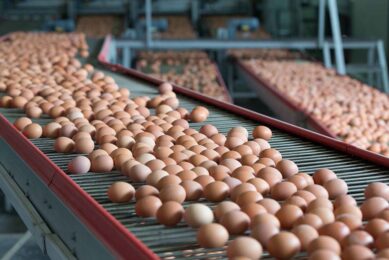FDA: new rules to reduce Salmonella from eggs
New federal regulations require most egg producers to take steps to prevent the spread of Salmonella enteritidis, reports the American Veterinary Medical Association.
The FDA rules affect the purchase of chicks and young hens, sanitation in production facilities, testing for the bacteria, and storage of eggs at farms with at least 3,000 laying hens. An FDA announcement states the rules are expected to reduce the number of S enteritidis infections by 60%, preventing about 79,000 cases of foodborne illness and 30 deaths annually.
The FDA also estimates the measures will decrease human health care costs and improve quality of life for consumers but cost egg producers about $81 mln annually.
Dr. Charles L. Hofacre, secretary-treasurer for the American Association of Avian Pathologists, said the FDA rules institutionalise practices that have reduced S enteritidis contamination in most of the industry, and he does not expect the regulations will have much impact on public health or on egg producers.
“For the table egg industry, it’ll be a very good way for them to showcase what they’ve been doing over the last few years,” Dr. Hofacre said.
Egg farmers began working with states and the United Egg Producers to develop quality assurance plans after S enteritidis contamination peaked in the late 1980s, Dr. Hofacre said. For companies that have not adopted measures similar to the new regulations, their most notable changes will likely relate to increased record keeping.
The regulations are published in a final rule that took effect on 8 September. Producers with more than 50,000 laying hens need to comply with the rule by July 2010, and those with more than 3,000 laying hens but fewer than 50,000 must comply by July 2012. The rules are expected to affect producers accounting for 99% of the nation’s egg production.
To comply with the new federal requirements, most egg producers must do the following:
– Have and implement a written S enteritidis prevention plan and document compliance.
– Buy only pullets tested for S enteritidis contamination or raise pullets under monitored conditions.
– Implement biosecurity and pest control programmes.
– Clean and disinfect poultry houses with positive S enteritidis test results.
– Refrigerate eggs at 45 F (9.44 C) during storage and transportation.
– Conduct environmental tests for S enteritidis and test eggs following positive environmental tests.
– Keep records related to flocks for one year after the flocks are permanently taken out of production.
– Make records available to the FDA within 24 hours of an official request.
– Producers must register with the FDA, which the Federal Register notice states will help the agency with annual inspections and resource allocation.
Dr. Hofacre said the regulations were the result of a few companies’ refusal to cooperate with the FDA and self-regulate to avoid egg contamination. He said it is unfortunate that a few producers’ actions led to increased regulation, but he does not disapprove of the new rules.
Dr. Eric N. Gingerich, a diplomate of the American College of Poultry Veterinarians and a staff veterinarian and adjunct assistant professor at the University of Pennsylvania’s School of Veterinary Medicine, expects his state’s diagnostic laboratory system will need more-sensitive equipment and more staff members to handle the final rule’s requirements. He also expects an increase in material costs associated with laboratory tests.
“The cost, according to our lab people, is going to be significantly higher for Pennsylvania producers—say, three times higher—for either the manure swab tests or the egg tests,” Dr. Gingerich said.
He estimates materials will cost $35 for each manure drag swab and $36 for each egg test. Producers using the Pennsylvania state laboratories pay for the cost of materials, but not labor costs, he said.
However, he said a United Egg Producers figure indicates eggs will cost consumers only about one cent more per dozen under the new rules.
Dr. Gingerich still has questions about what producers should do after positive test results in areas where there are no buyers of pasteurized eggs, what training is planned for implementation of the rule, and whether recalls will be required following positive test results.
While Dr. Gingerich thinks the tests will remove some S enteritidis-positive eggs from the market, he said egg producers have largely gained control over the bacteria since the FDA rule was proposed in 2004.
The FDA proposal was similar when introduced in September 2004, and the agency held public meetings in 2004 and accepted comments through July 2005. The 2004 proposal and the 2009 final rule were developed as part of a series of farm-to-table egg safety efforts that the FDA and the Department of Agriculture’s Food Safety and Inspection Service started in the 1990s, the Federal Register entry states.
Source: American Veterinary Medical Association
Join 31,000+ subscribers
Subscribe to our newsletter to stay updated about all the need-to-know content in the poultry sector, three times a week. Beheer
Beheer








 WP Admin
WP Admin  Bewerk bericht
Bewerk bericht